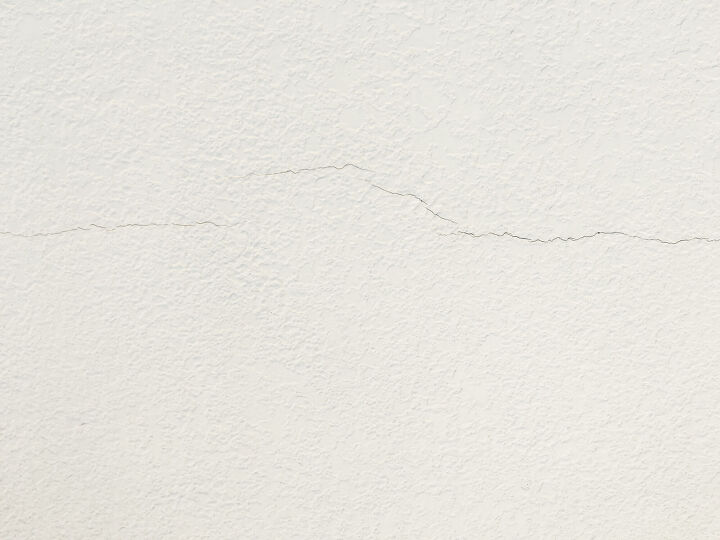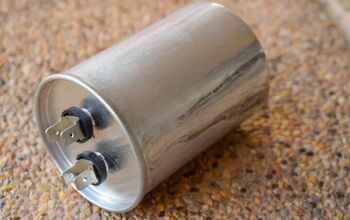6 Types Of Ceiling Cracks And How To Fix Them

When you discover cracks in your ceiling, of course, they are unappealing, but you may be wondering whether or not they pose a serious threat to your home. In most cases, ceiling cracks can be easily repaired. Though uncommon, there are instances where cracks in the ceiling may be a more extensive issue. The seriousness of a ceiling crack ultimately depends on the location, size, and type.
There are various types of ceiling cracks, caused by structural damage, normal foundation settlement, or just poor workmanship. We ranked the types of ceiling cracks from least to most serious:
1. Hairline cracks
2. Brown or yellow cracks
3. Spiderweb cracks
4. Straight cracks
5. Cracks between the wall and ceiling
6. Large, deep cracks due to bowed ceiling
We’ve put together all you need to know about the types of ceiling cracks, including how to know when a crack is serious, what causes them, the proper repair steps, and when it may be necessary to contact a foundation professional.
Do You Need Wall and Ceiling Contractors?
Get free, zero-commitment quotes from pro contractors near you.

What Causes Ceiling Cracks?
There are essentially two primary causes of ceiling cracks: Natural settling that occurs as a structure ages and structural damage. Though, ceiling cracks are also commonly caused by poor workmanship or installation. With this in mind, here are all the various causes of ceiling cracks:
- Moisture damage. Whether moisture is coming from your roof or from the floor immediately above the ceiling where the crack is located, moisture damage is a common cause of ceiling cracks. Perhaps you recently had a powerful storm in your area and a considerable amount of rainfall or you may have a plumbing leak above your ceiling.
- The age of your home. Over time, it’s inevitable that your home is going to experience normal wear and tear. This includes foundation settling, which occurs as a structure ages and often results in ceiling cracks, as well as floor and wall cracks.
- A problem with the drywall. If your drywall was improperly installed, it will often crack and cracks in ceiling drywall are usually not a major cause for concern. This commonly occurs when drywall joints are taped incorrectly. In other words, the installer did not use enough drywall mud when taping the joints, which prevents the tape from sticking. As the tape comes loose, the drywall cracks.
- The floor above the ceiling is too heavy. It’s possible that your ceiling does not have enough support to compensate for the floor above it. This is especially the case for bathrooms, as they consist of very heavy items such as bathtubs and shower enclosures. Or, perhaps the attic above the ceiling contains a very heavy item.
- Foundation problems. Unfortunately, cracks in your ceiling may also indicate serious structural damage. As previously mentioned, foundation settlement can result in ceiling cracks. When your foundation settles, it puts substantial stress on a building’s frame. When ceiling cracks are caused by structural damage, it’s important that you catch them early and repair them as soon as possible.
Types of Ceiling Cracks
Even though buildings may appear to be stationary, they’re not. All structures, whether they’re steel, concrete, wood, or some other material, shift. Though imperceptible, this movement is caused by a variety of factors including season temperature changes that cause the soil underneath the structure to shrink and expand. It also results from natural settling that happens overtime.
For this reason, some cracks in ceilings and walls of your home can be expected and are typically nothing to worry about. However, there are certain cracks that indicate a major structural issue. Regardless, it’s important to know all the types of ceiling cracks so that you can repair them accordingly.
1. Hairline Cracks
Hairline ceiling cracks are very thin cracks – typically 1/16th of an inch or smaller. In most cases, they are cosmetic in nature and while they may look unnerving, they are almost always not dangerous. These cracks are most commonly caused by old paint or plaster over drywall.
When walls have been painted over several times without removing the old paint underneath, problems can arise. As the old paint dries and curls, it causes the top layer to splinter and form these hairline cracks. On the other hand, changes in temperature and humidity can cause the plaster over drywall to contract or swell, resulting in small cracks.
Fortunately, hairline cracks are not serious and be fixed with minor cosmetic touch-ups. You can either choose to ignore these cracks or use paint to touch them up.
2. Brown or Yellow Cracks
If you have discolored cracks on your ceiling, this is usually a sign of a water leak. A yellowish or brownish tinge at the edges of a ceiling crack is an indication of moisture damage. In this case, you’ll want to start looking for water where it should not be. Before you repair the drywall, you must locate and address the leak. Oftentimes, it’s best to hire a professional for these types of cracks and prevent the problem from getting worse.
After the cause of the water damage has been taken care of, you must repair the ceiling. Though, before you can begin performing any work, you must allow your drywall to dry out completely. If the drywall is completely saturated or the affected area is extensive, you’ll have to completely remove the drywall in those areas.
How to Remove Drywall
Use a knife to cut away at the point where the molding meets the drywall. Then, use either a sledgehammer or a small mallet to carefully create holes in the center of the drywall. The goal is to avoid hitting the joists, otherwise you risk causing further structural damage. Once the hole is somewhat sizable, use a crowbar to pry the remaining drywall away.
Note: Make sure that you’re wearing gloves for this task!
How to Replace Ceiling Drywall
Once the drywall is removed, sand the edges of the drywall so that they are clean and straight. To stick the drywall to the joists, you’ll need to use specialized drywall adhesive and t-braces to keep it in place. These t-braces will hold the drywall to the ceiling as the adhesive cures.
3. Spiderweb Cracks
As the name suggests, spiderweb cracks appear like spiderwebs and are usually caused by foundational settling or cracking paint or plaster. They have a central point, with thin cracks extending outwards in all directions. If the drywall was applied too thickly, it can result in thin, spiderweb-like cracking as it shrinks during the drying process.
These cracks could also be an indication of compromised structural integrity. Though, if the spiderweb cracks are smaller than 1/16th of an inch, they are usually not serious. In most cases, all you have to do to fix spiderweb cracks is to sand off some of the existing compound and apply a fresh coat.
4. Straight Cracks
Cracks in the ceiling that are essentially a straight line are usually a result of improper taping or mudding during drywall installation. If not enough mud was applied, the tape cannot stick properly to the joints and will start to pull away, causing a crack in the plaster. Excessive humidity as well as foundational settling can also cause straight cracks.
Since these cracks are usually superficial in nature, you can often fix them by applying some drywall compound to the tape so that it will stick properly back to the joints. Though, there are some instances where you may have to completely replace the tape. To do this, use a razor knife for removing the loose tape and then sand the surface underneath (but, do not sand into the drywall paper).
Then, apply a new strip of drywall tape and a thin layer of drywall compound with a putty knife. Before you sand again, allow the compound to dry completely.
5. Cracks Between Wall and Ceiling
If you have a crack in the spot between your ceiling and an adjacent wall, this is usually caused by truss uplift. Your roof trusses are designed to move and shift as the wood expands and contracts with changes in heat and humidity. It’s possible for the trusses to shift so much that it lifts the ceiling away from the wall. An intense windstorm can also cause the trusses to shift and result in the ceiling lifting away.
In either case, there will be a visible gap between the wall and the ceiling. This is particularly common when drywall was incorrectly installed to the ceiling on a non-load-bearing wall. Since these cracks are not caused by structural problems, you can usually fix them by covering them with a layer of paint or installing crown molding all along the ceiling. Though, it’s highly recommended that you call in a professional for the job.
Do You Need Wall and Ceiling Contractors?
Get free, zero-commitment quotes from pro contractors near you.

6. Large, Deep Cracks Accompanied by Bowing
If you have large, deep cracks in your ceiling and bow or sagging, this is a strong indication of major structural damage. These cracks can be caused by a number of things such as extensive water damage, substantial settling, or even excessive weight on the floor above. Or, if you recently removed a load-bearing wall and did not add additional support, this can cause partial ceiling collapse.
In this case, since it’s very possible for the ceiling to collapse, you must immediately remove anything on the floor both above and below the crack. Then, contact a professional right away to diagnose the cause of the crack and recommend the proper solution.
How to Fix Ceiling Cracks

Jessica considers herself a home improvement and design enthusiast. She grew up surrounded by constant home improvement projects and owes most of what she knows to helping her dad renovate her childhood home. Being a Los Angeles resident, Jessica spends a lot of her time looking for her next DIY project and sharing her love for home design.
More by Jessica Stone


















![How Much Weight Can a 4×4 Support Horizontally? [It Depends!]](https://cdn-fastly.upgradedhome.com/media/2023/07/31/9070333/how-much-weight-can-a-44-support-horizontally-it-depends.jpg?size=350x220)














